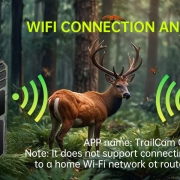Do you understand where hunting cameras come from?-Hiicam
The history of hunting cameras, also known as trail cameras, dates back several decades and reflects advancements in photography and technology.
Early Days (1960s-1980s): The first trail cameras were essentially modified still cameras. Hunters would set up these cameras on tripods or trees to capture images of wildlife. They often used manual film and required regular maintenance and film development.
1990s: The introduction of infrared technology allowed for motion-activated cameras. These models significantly improved the ability to capture images of wildlife without human presence. They became more popular among hunters for scouting purposes.
Early 2000s: Digital technology transformed hunting cameras. The switch from film to digital made it easier to store and retrieve images, and hunters no longer had to develop film. This era saw the rise of wireless cameras that could send images directly to a smartphone or computer.
2010s: The advancement in battery technology and image quality led to cameras with higher resolutions and longer battery life. Features like video recording, enhanced night vision, and cellular connectivity became common.
Current Trends: Today’s hunting cameras come with a wide range of features, including GPS, advanced motion detection, and even live streaming capabilities. They are compact, durable, and designed for a variety of environments, making them essential tools for modern hunters.
History of Hunting Cameras 2024














